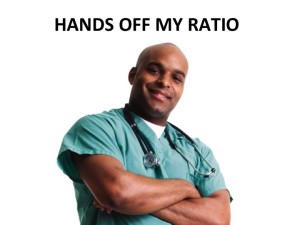 Nursing workload revolves around nurse to patient ratios. It makes each nurse responsible for his/her own patients.
Nursing workload revolves around nurse to patient ratios. It makes each nurse responsible for his/her own patients.
Managers cannot ignore ratios and keep their jobs. Ratios drive union grievances.
A great ratio makes a tough nursing assignment manageable. A ward with terrible ratios drives nurses away.
Nurse to patients ratios are sacrosanct to many. But rigid ratios create big problems if a clinical area sees unscheduled visits.
Question: How can you schedule a fixed ratio of patients for every nurse, if an emergency department must see everyone who shows up?
Answer: By making everyone wait in the waiting room to protect rigid nurse to patient ratios inside the ED.
This blog & podcast summarize the key points from Step 3 – Redefine Nurse to Patient Ratios in No More Lethal Waits: 10 Steps to Transform Canada’s Emergency Departments.
Nurse to Patient Ratios
If 120 patients have registered to your ED, and 12 nurses are working, then the nurse to patient ratio is 1:10. Pretending that the ratio is 1:4 or 1:6 inside the ED puts patients at medical risk in the waiting room. It also puts the hospital at risk of lawsuit should someone die while waiting.
Emergency departments must assume they have unlimited capacity. They must see everyone. Rigid nurse to patient ratios work on inpatient wards, not in the ED. If you Close the Waiting Room and bring everyone inside right after triage, you need to redefine nurse to patient ratios.
Doctors must see and discharge patients to drop nurse to patient ratios from 1:10 down to an ideal of 1:6 or 1:4. EDs need to see patients, treat them, and send them home (or admit them). Pretending patients do no exist, because they sit in the waiting room, puts patients at risk.
Buy In
Nurses work hard caring for patients and many will go far beyond duty to help. But nurses stay alert for managers who might take advantage of them.
How can you get nurses to bend the rules around ratios?
Speak to nurses’ core motivation for caring. Hard work now makes life easier later; it decreases patients’ length of stay (LOS). Reduced LOS improves job satisfaction and decreases the overall work for the nursing team.
Teams that pull together, help each other out, and get patients seen and sent home as promptly as possible end up with the lightest work load overall. And they end up giving patients exactly what they want: a diagnosis and treatment as quickly as possible.
As we run out of money, EDs try to do as little as possible for as many patients as time allows. A poverty mentality creates an ED with no resilience, no ability to respond to a surge in volumes. We need ED teams to take an abundance approach and do as much as they can for every single patient so that when a crisis hits, teams have resilience to respond.
RN concerns
Two nurse managers, 2 nurse coordinators, and an RN educator offered the following comments about No More Lethal Waits ED:
– After a few months, nurses come around and support the new approach. It’s much safer than letting patients wait for hours. But it takes time to get used to it.
– RNs talk about guidelines and their license when you discuss change. They’re often just “covering their butt”.
– Nurses worry that trimming triage = trimming RN positions. Reassure them that triage RNs get redeployed into the ED. We do not cut RNs with this transformation
– Triage is NOT safer
– Nurses have a rule-based culture. Change and innovation are hard.
– RNs often do clerical work because it’s easier
– New grads take a year to train and orient to the ED. In the old days of hospital nursing training, they were ready to go from day 1.
– Partner with your unions!
– Hire well (and fire promptly).
– RNs worry that decreasing the role of triage will decrease the influence of RNs on emergency care
– Sacred cows: triage, RN to patient ratios, culture, and history
– Change: people think they want it but get worked up over “how it used to be”
There’s a tonne more in the book, but I hope this gives a sense of the chapter. Please share your thoughts below or email me. Thanks!
